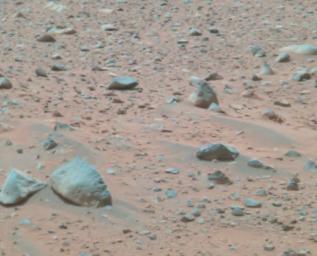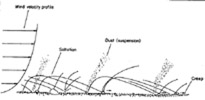
|
Ripples or Dunes?
- Click the image above for a larger view
- Full-Res JPEG (1012 x 818) (93.3 kB)
- Full-Res TIFF (1012 x 818) (2.4 MB)
Caption:
This approximate true-color image taken by the Mars Exploration Rover Spirit's panoramic camera shows the windblown waves of soil that characterize the rocky surface of Gusev Crater, Mars. Scientists were puzzled about whether these geologic features were "ripples" or "dunes." Ripples are shaped by gentle winds that deposit coarse grains on the tops or crests of the waves. Dunes are carved by faster winds and contain a more uniform distribution of material. Images taken of these features by the rover's microscopic imager on the 41st martian sol, or day, of the rover's mission revealed their identity to be ripples. This information helps scientists better understand the winds that shape the landscape of Mars. This image was taken early in Spirit's mission.
 Click on image for larger view
Click on image for larger view
[Image credit: NASA/JPL/ASU]
This diagram illustrates how windblown sediments travel. There are three basic types of particles that undergo different motions depending on their size. These particles are dust, sand and coarse sand, and their sizes approximate flour, sugar, and ball bearings, respectively. Sand particles move along the "saltation" path, hitting the surface downwind. When the sand hits the surface, it sends dust into the atmosphere and gives coarse sand a little shove. Mars Exploration Rover scientists are studying the distribution of material on the surface of Mars to better understand how winds shaped the landscape.
Cataloging Keywords:
| Name | Value | Additional Values |
|---|---|---|
| Target | Mars | |
| System | ||
| Target Type | Planet | |
| Mission | Mars Exploration Rover (MER) | |
| Instrument Host | Spirit (MER-A) | |
| Host Type | Rover | |
| Instrument | Panoramic Camera (Pancam) | |
| Detector | ||
| Extra Keywords | Atmosphere, Color, Crater, Dune, Dust | |
| Acquisition Date | ||
| Release Date | 2004-02-26 | |
| Date in Caption | ||
| Image Credit | NASA/JPL/Cornell | |
| Source | photojournal.jpl.nasa.gov/catalog/PIA05452 | |
| Identifier | PIA05452 | |
